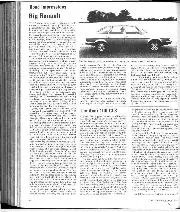
The Audi 100 GLS
Although I suppose the Audi 100GLS with a mere four cylinders is now overshadowed by the latest Audi models with five cylinders apiece, I rate it as a very good…
HERE AND THERE.
A Useful Handbook for Ariel Owners.
The Book of the Ariel. By G. S. Davison. (Pitman. Illus. 2s. net.) Although of interest to all enthusiastic motor cyclists, Mr. Davison’s book is designed to cater specially for the riders, and prospective riders, of the well known Ariel motor cycle. In the preface, the author says that he Was puzzled as to what should be omitted from the
book, and indeed he was confronted with no small problem. He has, however, surmounted this difficulty with success, and nothing of importance has been left unsaid, and no subject of especial interest has been left untouched. In a book of this sort, it is extremely difficult to write in an interesting way, and to avoid the highly technical, but Mr. Davison has contrived to make each
chapter interesting and easily understandable to even the most recent recruit to the pastime of motor cycling.
Together with the many excellent diagrams and photographs, the book makes most excellent reading, and the author is to be congratulated on handling his subject with such manifest success. He begins with a description of the various models and their parts, and passes via Running Costs to such ,matters as Law and Insurance, which affect motor cyclists. There are ” running-in ” awl driving hints,
and an excellent chapter on the maintenance and tuning of the Ariel, where every part of the machine is mentioned. Of especial interest are the chapters on tuning for competition work, together with hints as to riding, both in reliability events and for speed trials. The little book concludes with an entertaining and well written history of the Ariel concern, and some very useful tables
of gear ratios, engine revolutions on various gears, gradient tables and lighting-up times, are included in the Appendix.
The Book of the Ariel is a worthy addition to the motor cyclists’ library series, and at two shillings is excellent value for the Ariel rider.
A Six-Port Levis Two Stroke.
The manufacturers of the Levis motor cycle, who, as is generally known, were the first to produce an aircooled two-stroke, have now brought out something altogether new in two-stroke design. The ordinary two-stroke engine has three or four ports and three moving parts—piston, connecting rod and crankshaft ; the new Levis has six ports, but it retains the simplicity of the standard type, in that it has only the same number of moving parts.
The six ports are made up as follows :—Two exhaust ports, one inlet port, two transfer ports, and a port in the piston itself. The last port makes it necessary for all the cold, incoming gas to pass around the under side of the piston head. This vital part of the engine is thus kept quite cool, and overheating and stuck rings are prevented. The new machine has been named the” Six Port Super-cooled” model, and its engine has a capacity of 247 C.C. (2f h.p.), while the machine, which is capable of over 6o miles per hour, is listed at .£39 ios.